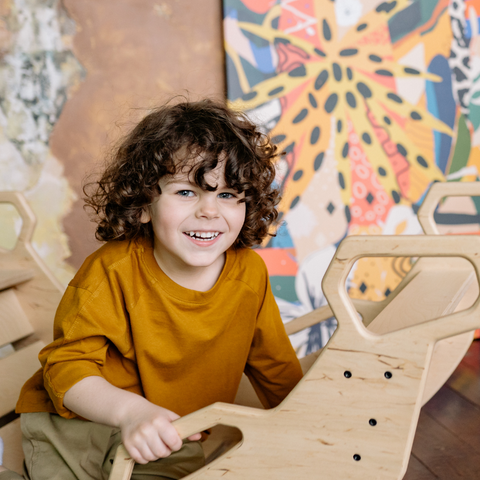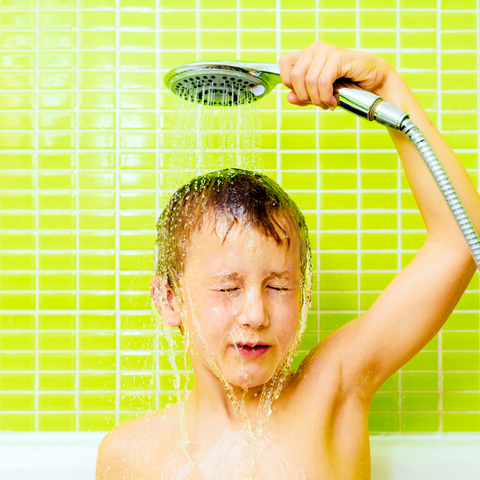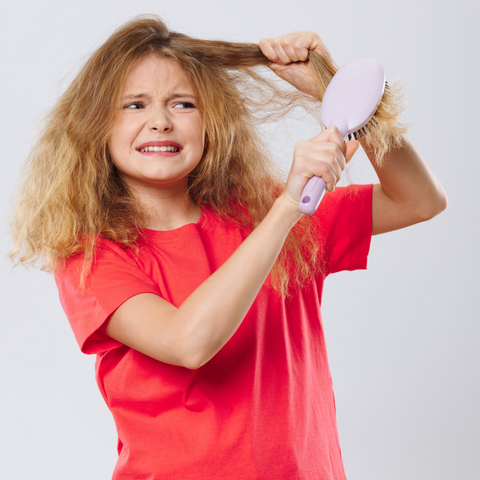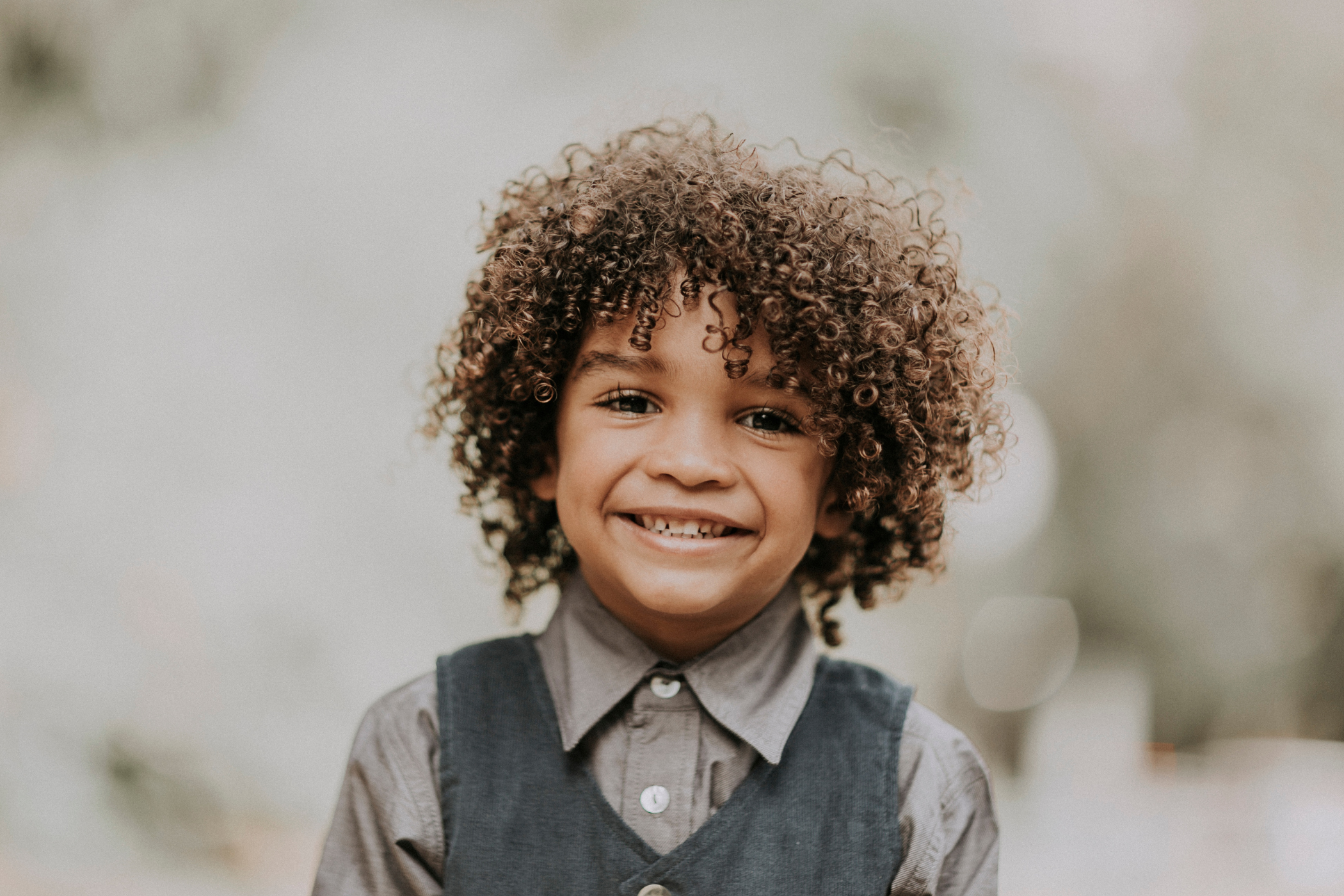We're here to make sure you have all the insight, advice, and tips needed to care for your child's curly hair - without all the tears! To start your child's hair care journey, let's look at the fundamentals you need to know.
- Identifying your child's curly hair type
- Washing and Styling
- Recommended styling products for your child's curly hair
- Styling tools
- Day 2 hair care and styling
- Nighttime routine tips
- Detangling your child's curly hair
- A curly kid's first haircut - when/how/who?
- Educating your child on looking after their hair
We've tried to make this topic - (as expansive as it is)- as simple as it can be! Because we know, that parenting is hard enough without overcomplicated handbooks and "helpful" guides full of impractical advice.
Below are some "quick look" categories to help you find exactly what you're looking for so you can get back to the more important things.
Knowing Your Child's Curls
- Identifying your child's curl type
- Curl types
- What to do when your child has curls and you don't!
Washing + Styling
- How to wash + condition your child's curls
- How to detangle your child's hair - without the tears!
- Can I use my tried-and-true "adult" products?
- Styling - HOW to style your child's hair
Hair Care Beyond Wash Day - Maintaining Your Child's Curls
- Day 2 and beyond
- Nighttime routine tips and tricks
- When is the right time for a first haircut?
- Teaching Your Child To Look After Their Curly Hair
Knowing Your Child's Curls
Understanding your child's unique curl type is a vital step in providing proper care for their precious locks. To make informed decisions, consider the following factors;

- 1. Curl Type: Identifying your child's specific curl pattern is crucial for selecting suitable hair products and styles. Without this knowledge, you may unknowingly mistreat their hair, leading to potential damage.
- 2. Hair Texture: Hair texture is determined by the diameter of each individual strand, categorised as fine, medium, or coarse. Understanding your child's hair texture helps decide which styles will hold well and how to best care for it.
- 3. Porosity: Assessing your child's hair porosity reveals its ability to retain moisture. Highly porous hair requires extra hydration to avoid dryness, while low porosity hair may need products that help penetrate and moisturise effectively.
- 4. Hair Elasticity: Elasticity refers to how easily your child's hair stretches or breaks and its overall flexibility. Low hair elasticity indicates a higher risk of breakage, necessitating specific products focused on strengthening and minimising damage.
- 5. Sebum Production of the Scalp: The scalp's sebum production, or oil, plays a role in scalp health. Understanding whether your child's scalp tends to be oily, balanced, or dry (prone to dandruff) enables you to address specific concerns with appropriate hair care products.

Identifying Your Child's Curl Type
When it comes to curly hair care for your little one, understanding their unique curl type is absolutely essential. It's not just about the curls but their texture, porosity, scalp sebum production, and hair elasticity.
As a parent, this knowledge will empower you to select the best natural hair products tailored to your child's needs. Imagine the confidence that comes with making informed choices for your kid's precious curls! So, let's dive into the world of curl types and give your child's hair the care it truly deserves.
The Curl Types
From sleek and straight to beautifully kinky, each strand of hair falls into its own distinctive category.
Types 1's
1a = Straight (Fine/Thin): This hair type is very soft, shiny, and challenging to hold a curl. It is typically damage-resistant and tends to be on the oily side.
1b = Straight (Medium): Hair in this category boasts lots of body, offering more volume and fullness.
1c = Straight (Coarse): This hair type is bone straight and often resistant to curling.
Type 2's

2a = Wavy (Fine/Thin): With a definite "S" pattern, this hair type can achieve a variety of styles and has a touch of waviness.
2b = Wavy (Medium): Hair in this category is slightly styling resistant and can be prone to frizz.
2c = Wavy (Coarse): Hair with thicker waves falls under this category. It is resistant to styling and tends to become frizzy.
Type 3's
3a = Curly (Loose Curls): Thick and full, this hair type showcases a pronounced "S" pattern and tends to get frizzy. It may have a combination of textures.
3b = Curly (Tight Curls): Hair in this category features a medium amount of curl and can exhibit a combination of textures.
3c = Curly (Corkscrews): This hair type can vary from kinky to very tight with tightly coiled corkscrew curls. It has a dense arrangement of strands.
Type 4's
4a = Kinky (Soft): This tightly coiled hair type is fragile but exhibits a more defined curl pattern.
4b = Kinky (Wiry): Also tightly coiled and fragile, this hair type has a less defined curly pattern, often resembling a "Z" shape.
4c = Kinky (Zingy): Curls in this category are tightly kinked, creating a distinctive and vibrant texture.
My Child Has Curly Hair, But I Don't?
As a parent, it can be challenging to navigate looking after curly hair care when you're unfamiliar with it. However, with some guidance, understanding and education, you can effectively care for your child's curly hair and ensure it remains healthy and beautiful.
First and foremost, embrace your child's unique hair texture. If you find that difficult to do because it seems like hard work - educate yourself. Learning about caring for textured hair's specific needs will genuinely help, and implementing a routine might seem manageable.

Regular moisturising is essential because curly hair tends to be more prone to dryness. Investing in the right tools and styling products you will need to take care of curly hair is a good first step.
One of the biggest mistakes parents make with their curly-haired kids, especially when they don't have textured hair, is they try to look after curly hair the same way they would straight hair. It's not their fault - curl education in Australia is relatively new, and we are still learning to embrace naturally textured hair. However, it's important to understand that curls have different needs.
If your child has curly hair, rather than just looking at your kid's hair as a tangled frizzy mess (which, let's face it, they often are!)
Look at your child's hair as potential for beautiful bouncy curls. "With a bit of help, education, and the right styling products, your child can not only have defined curls, but also learn how to look after their curls themselves".
Even if you don't have curly hair, you can create a positive and nurturing hair care routine for your child's curls that will benefit them in the years to come.
Washing + Styling
How To Wash + Condition Your Child's Curls
Washing your hair is essential- however, 'wash day' is an important ritual in curly hair maintenance. Please don't panic, it doesn't have to be a stressful experience. It's easy once you know how.
Step 1. Use a gentle cleanser that is free of harsh ingredients. Make sure to thoroughly and evenly wet your child's hair before applying the cleanser.
Step 2. Apply the cleanser to the scalp and work it in towards the ends.
Step 3. Avoid scrubbing the curls too harshly, and instead, use your fingertips to massage the cleanser in a gentle circular motion.
Step 4. Once finished, use lukewarm water to rinse out the cleanser.
Step 5. Apply a Conditioner to the ends of the hair and gently brush through with your Flexi Brush. Rinse thoroughly and give the curls a gentle scrunch with your hands. You can dry and style your little one's curls from here on.

How To Detangle Your Child's Hair – Without The Tears!
Detangling can be the hardest part of your child's hair care routine, especially if your child has a lot of hair that tangles easily. However, with a bit of care and know-how it doesn't have to yield tears and frustration. (for your child or YOU!)
To make the process easier, try using a detangling spray and a detangling brush. Start at the end of the hair and slowly work your way up, and be sure to stop brushing if there is too much resistance.
As an alternative to detangling brushes, you can also try finger detangling, which some find to be more precise and gentle, remember adding more water can help with more challenging tangles.
Pro Tip: when you find a knot, instead of brushing down and compacting the knot, use your fingers to open and spread the knot out, then continue with the brush to open the knots not compact them.
Styling "Stuff": Can I Use My Tried And True Adult Products

It's a questions stylists get asked all the time! The short answer is yes!
Depending on how you're styling your kids' hair, you can use different styling products and tools to suit your child's daily needs. If you've got curls yourself, you probably have a good supply of curl creams and gels. If you're already following a Curly Girl routine, your products will be safe to use on your child. It's always good practice however, to double-check that your products are organic, natural and free from any nasty chemicals like SLSs, sulphates and silicones before using on a little one.
If you're going for a wash-and-go hairstyle, you'll want to use a curl-defining cream and lightweight gel to add definition and hold. You can use a diffuser on a low heat setting for some extra definition.
Styling - HOW To Style Your Child's Hair
For weekdays, let's be real; most kids are required by school policy to have their hair tied back and out of their faces whether it's High school, Primary, Preschool or Daycare. (Ain't no-one got time for Nits - Gross!)

Eventually, your child will learn how to style their own curly hair, and with some education and the right products, learning a simple curly wash and styling routine will become second nature.
Hair Care Beyond Wash Day - Maintaining Your Child's Curls
Day 2 and Beyond
To help extend the longevity of those beautiful curls in between wash days, teach your child the best routines for refreshing curls.
There are loads of tricks for refreshing curls. However, the simplest way to refresh is by using a light spritz of water or a curl refresher spray followed by a light curl cream or moisturising product. Adding water *should activate the gel that was already applied on wash day, however, if your child's hair needs a bit of extra hold on a refreshing day, you can use a bit more gel. (Emulsifying in the palm of your hand with water is a good way to apply it to your little ones' curls).
Pro Tip: Avoid using too much product, as this can add weight and drag down the curls over the week.

Night Time Routine Tips And Tricks
To help maintain healthy, bouncy curls, you'll want to teach your child a good nighttime routine. Most little kids shower at night time, so it's a good rule of thumb to encourage warm showers- not hot.
Heat can activate frizz and cause the hair to absorb moisture in the wrong way.
To protect the hair overnight from breakage and knots, invest in a Hair Cozy or scarf to cover the hair overnight. A silk pillow slip is also an excellent investment. They feel nice to sleep on, but for wriggly sleepers that might cause a Cozy to fall off, it adds an extra layer of sleep protection.
When to Cut Your Child's Curls – What You Need To Know About The First Curly Haircut
It can be nerve-wracking to make that first appointment for your child's haircut, but it doesn't have to be! When looking for a stylist, find one that specialises in curly hair. Be sure to discuss the desired look before the cut so you're both on the same page. On the day of the appointment, talk to the stylist about what you would like in your kids' haircut, and it's always important to mention that it's their first haircut. Usually, a hairdresser will save a snip for you as a keepsake.

Preparing your child for their first haircut is also a good idea.
Children, even if they have never been to a hairdresser, can suffer a lot of anxiety around getting their hair cut, so make sure the first one is a success!
For girls, talk about the length and style they want (depending on their age and communication ability). Mention how much easier the hair will be to brush and that it will have less tangles.
For boys (or girls getting a unique style), it's always a good idea to talk about the clippers. Whilst clippers are harmless and not dangerous, they can be pretty scary to a little person! Especially if that child has any underlying sensory issues.
Pro Tip: Bring snacks!! Or their fav book or iPad.
Teaching Your Child To Look After Their Curly Hair
Teaching your child to look after their curls is an incredibly empowering and important part of their hair care routine. If you yourself have curly hair, encourage them to follow the same steps and use the same products you do to maintain their curls. If you don't have curly or textured hair, contact a curl specialist for advice. It will save you plenty of frustration in the long run when your kid knows how to look after their own hair as they grow up.

As they practice, you can help guide them and give advice. Above all, show them how confident and beautiful they look with their unique, textured hair.
No matter your curly kid's hair type, this Ultimate Curly Kids Handbook will give you the insight and guidance to keep those ringlets healthy and happy - without tears! So settle in, and let's get started!



Straight Talk! Our Candid Review of the Dyson Airstrait Straightener: Is It a Must-Have or a Hard Pass?
Mastering The Art Of “Short” Curly Hair: Step-By-Step Styling Techniques For Shorter Hairstyles